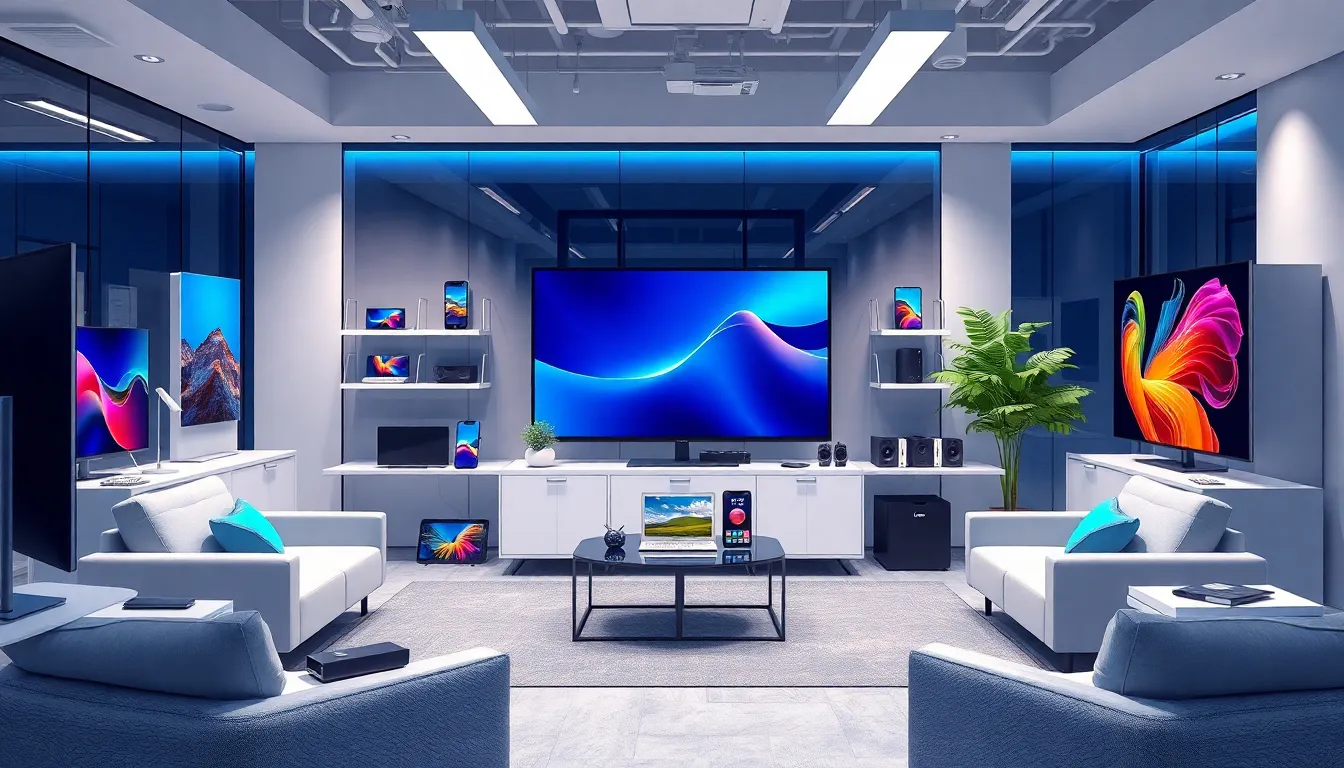In a world where gadgets seem to sprout like weeds, consumer electronics companies are the wizards behind the curtain, conjuring up devices that make life easier and a whole lot more fun. From smartphones that practically think for us to smart fridges that keep tabs on our snack habits, these companies are on a mission to turn our wildest tech dreams into reality.
But let’s face it, navigating this tech jungle can feel like trying to find a needle in a haystack—if that haystack was made of tangled cords and confusing manuals. With innovation at their fingertips, these companies are not just selling products; they’re crafting experiences that keep us plugged in and powered up. Buckle up as we dive into the fascinating world of consumer electronics and uncover what makes these companies tick (and beep, and buzz).
Table of Contents
ToggleOverview of Consumer Electronics Companies
Consumer electronics companies play a crucial role in shaping modern technology and its impact on daily life. These companies focus on designing, manufacturing, and marketing devices that enhance the convenience and efficiency of consumers’ routines. Key products include smartphones, laptops, wearables, televisions, and smart home devices.
Major Players in Consumer Electronics:
- Apple Inc.
Apple stands as a leader in consumer electronics, known for its innovative smartphones and laptops. The iPhone and MacBook set industry standards for performance and design.
- Samsung Electronics
Samsung specializes in a wide range of electronics, including TVs, smartphones, and home appliances. Its commitment to innovation drives advancements in display technologies and smart home integrations.
- Sony Corporation
Sony excels in audio and visual consumer electronics, offering products such as gaming consoles, headphones, and cameras. Its PlayStation brand remains dominant in the gaming market.
- LG Electronics
LG focuses on home appliances and smart technology, producing high-quality TVs, refrigerators, and washing machines. Its commitment to energy-efficient products appeals to environmentally conscious consumers.
- Xiaomi
Xiaomi rapidly gained market presence through affordable smartphones and home gadgets. Its strategy combines technology and affordability, attracting a diverse consumer base.
Emerging Trends in the Industry:
- Smart Home Integration
Companies are increasingly introducing products that connect seamlessly within smart home ecosystems. Devices like smart speakers and IoT-enabled appliances enhance automation.
- Sustainability Initiatives
Many companies prioritize eco-friendly practices, from sourcing materials to energy-efficient manufacturing processes, appealing to a growing segment of eco-conscious consumers.
- Artificial Intelligence
Incorporating AI into consumer electronics improves user experience through personalized recommendations and automation, marking a significant shift in product capabilities.
Consumer electronics companies drive technological evolution, constantly redefining the landscape of everyday devices. Their efforts shape consumer choices, aligning with the latest industry trends and user demands.
Key Players in the Industry

The consumer electronics industry boasts several influential companies driving innovation and shaping consumer experiences. Their roles define market trends and set benchmarks for quality and technology.
Major Brands and Their Impact
Apple, Samsung, Sony, LG, and Xiaomi lead the consumer electronics landscape. Apple excels in user-centric design, revolutionizing smartphones with the iPhone and expanding into wearables like the Apple Watch. Samsung dominates the display market, offering cutting-edge TVs and smartphones with advanced features. Sony innovates through gaming consoles and audio products, impacting the entertainment sector. LG focuses on home appliances and smart technology, promoting energy efficiency. Xiaomi captivates consumers with affordable smartphones and smart home devices, challenging established brands with competitive pricing. Each brand contributes distinct value, driving market evolution.
Emerging Companies to Watch
Several emerging companies showcase potential for significant impact on the consumer electronics sector. One such company, OnePlus, focuses on high-quality smartphones at competitive prices, attracting a dedicated user base. Another rising star, Anker, specializes in charging technology and smart home devices, emphasizing reliability and user satisfaction. Ring, known for its smart home security solutions, leads innovation in home safety. Furthermore, Oppo and Vivo are expanding their presence with advanced smartphone technology tailored to young consumers. These companies exemplify the shift towards diverse offerings and heightened consumer engagement in the ever-evolving electronics market.
Trends in Consumer Electronics
The consumer electronics landscape continuously evolves, shaped by various innovations and shifting consumer preferences. Companies adapt quickly to these trends to stay relevant and competitive.
Innovations Shaping the Market
Companies emphasize smart technology, with features like voice assistants and IoT capabilities defining new products. 5G technology enables faster connections, enhancing the use of mobile devices and improving streaming quality. Foldable screens emerge as a breakthrough in smartphone design, allowing for larger displays in compact formats. Other significant innovations include artificial intelligence, which optimizes user experiences in devices and enhances functionality in products such as smart appliances and wearables. Companies increasingly focus on incorporating sustainability into product design, using recyclable materials and energy-efficient solutions.
Consumer Preferences and Behavior
Consumers favor devices that enhance convenience and connectivity. Brands integrating smart home features, such as voice control and remote monitoring, gain popularity among tech-savvy users. Personalization also plays a vital role; customers are drawn to products that offer customizable settings and tailored content recommendations. Price sensitivity persists, prompting brands to balance innovation with affordability. Additionally, eco-conscious consumers prioritize sustainability, pushing companies to promote environmentally friendly devices. As digital natives grow in numbers, expectations around seamless technology integration and user-friendly interfaces continue to shape purchasing decisions.
Challenges Faced by Companies
Consumer electronics companies encounter various challenges that impact their operations and market performance.
Supply Chain Issues
Supply chain issues disrupt production and distribution, affecting product availability. Companies face delays due to raw material shortages, transportation bottlenecks, and geopolitical tensions. For instance, the COVID-19 pandemic exacerbated these issues, leading to significant chip shortages impacting various electronic devices. Companies such as Apple and Samsung often struggle to secure components for their devices, which results in extended lead times and inventory shortages. Strategic partnerships with suppliers and diversified sourcing strategies are crucial for mitigating these challenges and ensuring a steady flow of products to meet consumer demand.
Competition and Market Saturation
Competition and market saturation challenge companies to distinguish their offerings. With numerous brands providing similar products, standing out has become increasingly difficult. Major players like LG, Sony, and Xiaomi constantly innovate to maintain market share amid intense rivalry. Moreover, emerging companies introduce cost-effective alternatives, further saturating the market. To remain competitive, established companies must invest in unique features, enhanced user experiences, and effective marketing strategies that resonate with consumers. Continuous engagement with consumer trends can guide companies in adapting their products to meet evolving preferences, allowing them to carve out niche markets within a crowded landscape.
Future of Consumer Electronics Companies
Consumer electronics companies are poised for transformation driven by technological advancements and changing consumer needs. Innovations in areas like artificial intelligence, augmented reality, and machine learning will shape next-generation devices.
- Artificial Intelligence: Companies are embedding AI in consumer electronics to enhance functionality. Smart assistants in devices will enable voice control, predictive recommendations, and personalized experiences. Products from companies like Amazon and Google illustrate this trend through their advanced smart speakers and home assistants.
- Smart Home Ecosystems: Integrating various devices into cohesive smart home systems is vital. Companies such as Apple and Samsung focus on creating platforms that allow interoperability between different brands. This interconnectedness enhances user experience and drives consumer interest in smart home technology.
- Sustainability: A growing emphasis on eco-friendly practices influences production methods. Companies are adopting recyclable materials and developing energy-efficient products. This shift reflects consumers’ preferences for sustainable solutions, impacting purchasing decisions.
- 5G Technology: The rollout of 5G networks accelerates mobile device capabilities, enabling faster data speeds and improved connectivity. This advancement allows for enhanced streaming, gaming, and seamless connection between smart devices, promoting innovation in mobile technology.
- Wearable Technology: The demand for wearable devices continues to rise, with companies like Fitbit and Apple leading the market. These devices offer health-tracking features, creating new opportunities for integration into consumer lifestyles.
- Emerging Market Competitors: Brands such as OnePlus and Xiaomi challenge established players by valuing affordability and innovation. This competitive landscape promotes rapid advancements and diverse product offerings in consumer electronics.
- User Experience Focus: Companies emphasize user-friendly interfaces and seamless technology integration. This focus meets the demands of increasingly tech-savvy consumers, influencing future product development.
Consumer electronics companies face immense opportunities and challenges. Their ability to innovate while addressing sustainability, connectivity, and user experience will determine their success in the evolving market landscape.
The consumer electronics industry is at a pivotal moment where innovation meets consumer demand. Companies are not just competing on features but are also focusing on creating seamless user experiences. As technology evolves rapidly it’s clear that adaptability and sustainability will play crucial roles in shaping the future.
The rise of smart home integration and AI-driven devices reflects a shift toward more personalized and connected living. With emerging brands challenging established players the landscape is becoming increasingly dynamic. This competition drives companies to push boundaries in design and functionality.
Ultimately the ongoing evolution in consumer electronics promises to redefine how individuals interact with technology daily. As these companies navigate challenges and embrace opportunities the future looks bright for tech enthusiasts and everyday users alike.




